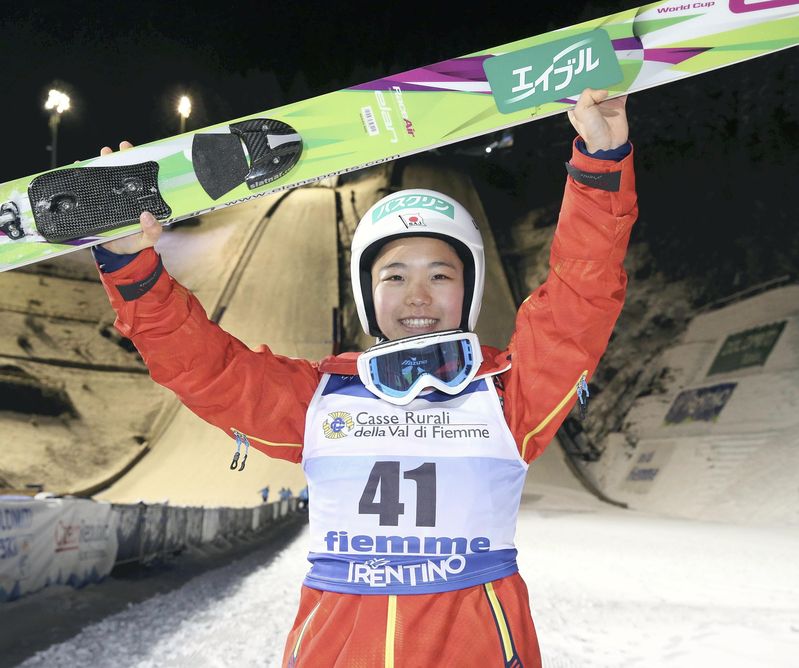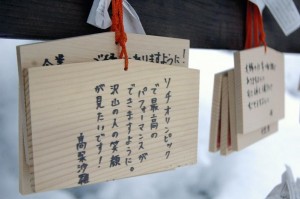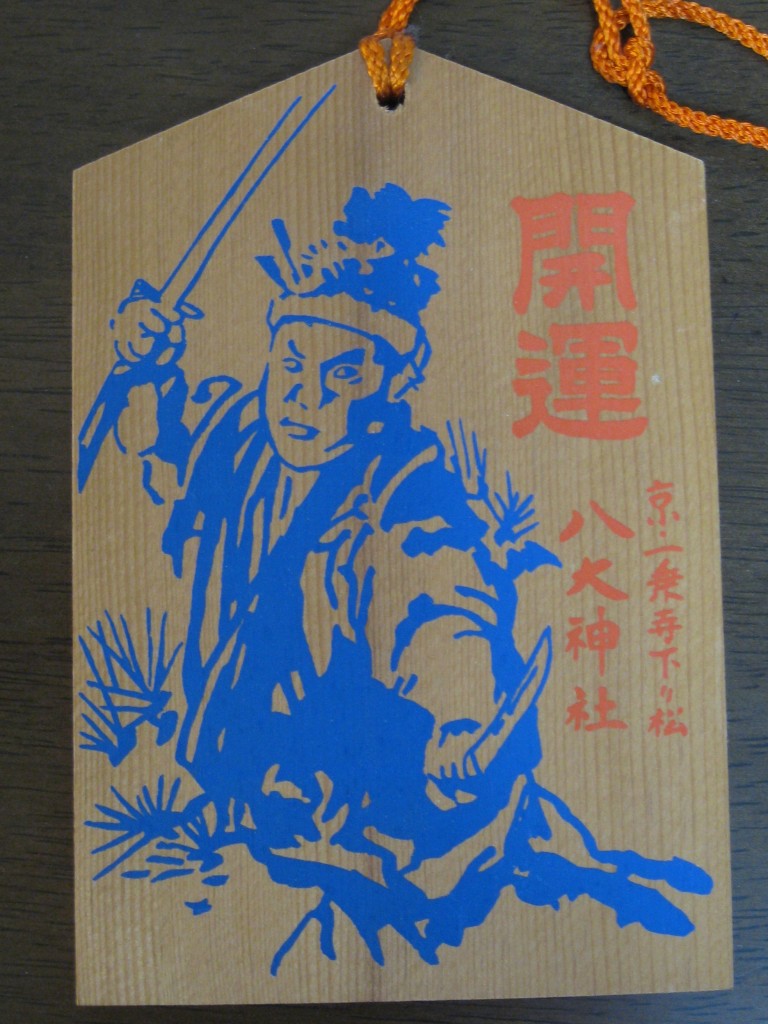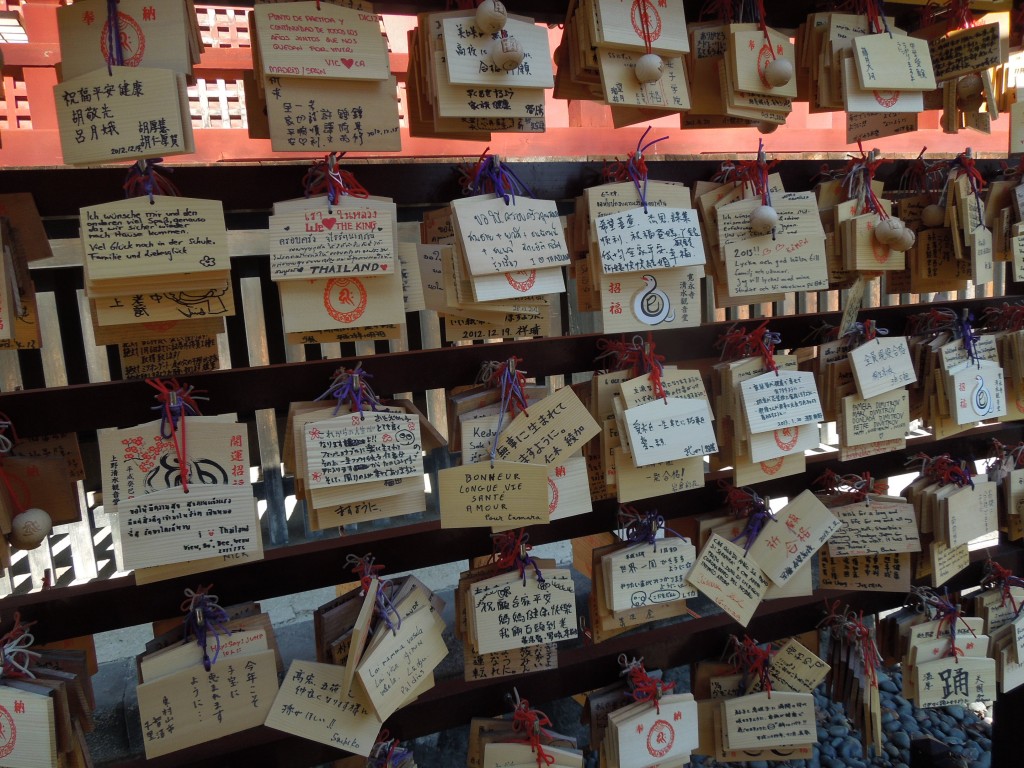
Will the kami smile on this potential Olympic champion? (copyright Yomiuri Shimbun)
An item in the Yomiuri Shimbun identifies another Olympic participant to keep an eye on in the coming days… will the kami shine on her fortunes? This time the article focusses on Sara Takanashi, a ski jumper. Being only 17, she’s apparently one of the generation without a clue about shrines, to the extent that she doesn’t know how to fill in an ema prayer request!
Confusingly the two women in the story below are named Takanashi and Takahashi. Interestingly, the older woman Takahashi retired to a distance while Takanashi wrote her ema request, but apparently later she had no qualms about checking what her younger friend had written – and then having it published in a newspaper. It highlights the very public nature of ema prayers.
**********************************************************************
Takanashi puts Olympic wish on Yamagata shrine tablet
The Yomiuri Shimbun February 08, 2014
“I hope to give my best performance at the Sochi Olympics. I want to see smiles on many people’s faces!”
This was the wish written by leading gold medal prospect Sara Takanashi on an ema wooden tablet at a shrine in Yamagata Prefecture. Takanashi will compete from Tuesday night (early Wednesday Japan time) in women’s ski jumping, a new event debuting at the Sochi Olympics.

The ema tablet on which Tanakanashi wrote her request for Olympic success. Shinto shrines are where you go for worldly benefits in this life, Buddhist temples for the afterlife. (copyright Yomiuri Shimbun)
The 17-year-old jumper set a new record for victories in women’s jumping at the World Cup by winning 10 World Cup meets this season.
Takanashi wrote her wish on a wooden tablet at Uesugi Shrine in Yonezawa, Yamagata Prefecture, a shrine dedicated to warlord Uesugi Kenshin of the Sengoku (warring states) period.
Takanashi visited the shrine in October last year while staying at the home of Megumi Takahashi, a cousin of her mother Chikage, in Takahana in the prefecture.
Takanashi was on her way to Kazuno, Akita Prefecture, a city close to Lake Towada where a competition was being held. Takahashi, 44, asked the teenager if she wanted to go to the shrine after they ate soba noodles, telling her it was said to lend spiritual power to its visitors.
After putting her palms together in prayer in front of the shrine, Takanashi suddenly said she felt like writing her wish on an ema tablet. A bit baffled as she was not accustomed to doing so, Takanashi asked, “Should I write my name?” and “Which side should face up?”

Prayers for victory can come in all shapes and sizes. This one is from Kyoto's Hachidai Jinja where the great swordsman Miyamoto Musashi defeated a host of enemies.
Takahashi watched the world-class athlete write her wish on the tablet from a distance. She first saw what Takanashi had written when she later visited the shrine for her first prayers of the New Year.
Takahashi was about to put up her own tablet, on which she’d written “I hope Sara will be able jump as well as she hopes,” when she happened to find the jumper’s carefully written tablet. They had written basically the same wish.
Takahashi used to visit Takanashi’s home in Kamikawa, Hokkaido, and has watched her grow since she was a baby. Takahashi still remembers how energetic Takanashi was when she talked about the appeal of ski jumping. Takanashi started the sport when she was just a second grader at primary school.
Takanashi suddenly attracted a lot of attention when she made a leap of 141 meters, setting a new women’s record for Okurayama hill in Sapporo, as she was only a second-year middle school student at the time. Since then, Takahashi has had fewer opportunities to meet her. However, in her eyes Takanashi is still “an ordinary girl who loves fun things and laughs a lot.”
Takahashi said she tries to avoid talking about jumping whenever she sees Takanashi. The two went to an amusement park when Takanashi threw the first pitch in the season opener between the Yomiuri Giants and Hiroshima Carp baseball teams at Tokyo Dome in March last year.
The female jumper told Takahashi she wanted to ride a pirate ship-shaped ride that swings 15 meters above the ground. Afraid of heights, Takahashi reluctantly sat at the end row of the ride, said to be the most thrilling place.
Takanashi sat next to her. Though Takahashi kept screaming on the ride, Takanashi laughed out loud, saying, “It’s not scary at all!” Her expression seemed too innocent for a world-class skier.
Takahashi will go to Sochi to watch Takanashi’s performance on the world stage. “I think she might be a little tense, as the Olympics is a big event. But I just want Sara to do her best in jumping,” said Takahashi. She prays that their wishes on the tablets will come true.

Ema in a variety of languages at a shrine in Tokyo's Ueno park, hung out in a public display. For Takanashi there was a question of whether to put her name, but the standard retort is that the kami need identification to make the wish come true.

I find the instruction in both standard shrine prayers and ema to not only to tell kami one’s name, but also one’s address, very interesting. Even for rituals like hitogata, the little human shaped paper dolls that you connect with your own life essence by breathing on them or rubbing them on your body, you often write your name on them. Not at all how I would expect holy spirits to operate. It naturally gives rise to images of kami operating via a very mundane kind of bureaucratic postal service, and by implication undercuts the notion that they would be all-knowing. Certainly some kami seem to be thought of as more powerful than others… Still, I wonder whether this particular aspect of Shinto lore might be a relatively recent addition!
Hi Quin…. My understanding is that ancestral spirits are considered to be immaterial human beings and as such there’s no thought of them being all-knowing. They continue with the same attributes as when they were living (Sugawara no Michizane aka Tenjin is a prime example, known for being a lover of plum trees, scholarly and a poet). Identifying oneself when addressing the kami would, I imagine, go back to ancient times, in much the same way that a subject would identify him- or herself when addressing an exalted superior such as a nobleman or emperor.
A very interesting hypothesis. It’s certainly very in line with the word “kami’s” origin as a form of address for anyone ranked above oneself. But of course not all kami are ancestral spirits. I guess “all knowing” is too much to assume for local nature spirits and so forth, but I should think most believers would assume that, for instance, Konohana Sakuya Hime is “all knowing” about who lives where around Mount Fuji.
But who knows! I guess we can’t know, unless the kami tell us themselves… :-)